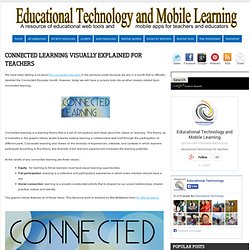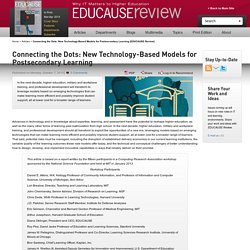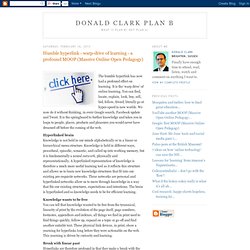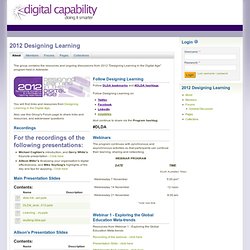

Tony Bates » 2020 Vision: Outlook for online learning in 2014 and way beyond. Global Learning Qualifications Framework - Assessing University-Level Learning Anytime, Anywhere. The Global Learning Qualifications Framework (GLQF) is designed to assess university-level learning regardless of where, when or how it was acquired.

The GLQF is the result of extensive research and builds on the progress of qualification frameworks from over 90 countries, the Lumina Degree Qualifications Profile, the Association of American Colleges and Universities (AAC&U) Essential Learning Outcomes and VALUE Rubrics, and other emerging work in the assessment field. May 2013 - Page 34. Connected Learning Visually Explained for Teachers. We have been talking a lot about the connected educator in the previous posts because we are in a month that is officially labelled the Connected Educator month, however, today we will have a cursory look into another closely related topic: connected learning.

Connected learning is a learning theory that is a set of conceptions and ideas about the nature of learning. This theory, as is indicated in the graphic below, works towards making learning a collaborative task built through the participation of different parts. Connected learning also draws on the diversity of experiences, interests, and contexts in which learners participate.According to this theory, this diversity of the learners experiences increases the learning potential. At the centre of any connected learning are three values : The graphic below features all of these ideas. Connected Learning Visually Explained for Teachers.
Connecting the Dots: New Technology-Based Models for Postsecondary Learning (EDUCAUSE Review. In the next decade, higher education, military and workplace training, and professional development will transform to leverage models based on emerging technologies that can make learning more efficient and possibly improve student support, all at lower cost for a broader range of learners.

Advances in technology and in knowledge about expertise, learning, and assessment have the potential to reshape higher education, as well as the many other forms of learning past matriculation from high school. In the next decade, higher education, military and workplace training, and professional development should all transform to exploit the opportunities of a new era, leveraging models based on emerging technologies that can make learning more efficient and possibly improve student support, all at lower cost for a broader range of learners. Workshop Participants Daniel E. Atkins, W.K. E-skillsUK - How to Prepare and Moderate Online Discussions for Online Learning. Understanding the Building Blocks of Online Learning: Humble hyperlink - warp-drive of learning - a profound MOOP (Massive Online Open Pedagogy)
The humble hyperlink has now had a profound effect on learning.

It is the ‘warp drive’ of online learning. You can find, locate, explain, look, buy, sell, bid, follow, friend; literally go at hyper-speed to new worlds. We now do it without thinking, in every Google search, Facebook update and Tweet. It is the springboard to further knowledge and takes you in leaps to people, places, products and pleasures you would never have dreamed off before the coming of the web. Hyperlinked brain Knowledge is not held in our minds alphabetically or in a linear or hierarchical menu structure. Knowledge wants to be free You can tell that knowledge wanted to be free from the tyrannical, linearity of print by the evolution of the page itself, page numbers, footnotes, appendices and indexes, all things we find in print used to find things quickly, follow up, expand on a topic or go off and find another suitable text.
Learning in the Open: Networked student identities. 2012 Designing Learning - Digital Capability. Michael's GDocs and other links: (You may need to be logged into GDocs to be able to continue to edit these pages) Session 1: Addressing the Global Trends - What are you/your organisation doing about them?

- Original wiki at Easier version for adding to at Session 2: Facilitate Disruptive Change - Develop that resource you would like to show your key decision-makers. List your resource at Session 3: Curate, Create, Aggregate - locate, generate and tag content to create usable resources. List of aggregating tools and resources at List of Allison's GDocs Session 1: TPCK – Technological Pedagogical Content Knowledge - What's it all about and how does it effect me? Session 2: Shifting the locus of control - Who controls the learning? Session 3: Copyright/Copyleft - managing online ownership and privacy – controlling what you know and how you use it -